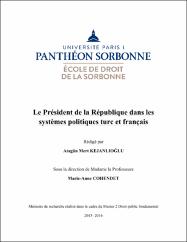Please use this identifier to cite or link to this item:
https://hdl.handle.net/20.500.11779/1075| Title: | Le Président de la République dans les systèmes politiques turc et français |
| Authors: | Kejanlıoğlu, Atagün Mert |
| Keywords: | Research Subject Categories::LAW/JURISPRUDENCE::Public law::Constitutional law Cumhurbaşkanlığı Kuvvetler ayrılığı Yarı-başkanlık sistemi Başkanlı parlamenter sistem |
| Publisher: | University of Paris 1 Pantheon-Sorbonne |
| Source: | Kejanlıoğlu, A.M. (2016). Le Président de la République dans les systèmes politiques turc et français, Université Paris 1 Panthéon-Sorbonne, Paris, France. ss. 1-221. |
| Abstract: | The President of Republic is becoming the central figure of the political system compared to the Prime Minister in Turkey, as it is in France, primarily as a result of the constitutional amendments regarding the election of the President of Republic by universal suffrage. However, French and Turkish Constitutions contain elements necessary to qualify these regimes as parliamentary. Both in Turkey and in France, the President of Republic has considerably important powers compared to classical parliamentary regimes as the President is entitled to use some of its powers without the counter signature of the Prime Minister. This, albeit crucial, is not enough to explain the role of the President of Republic within these political regimes. By distinguishing the political regime - defined as the regime established by the Constitution - and the political system - defined as the system that appears in practice - we are able to offer a more detailed insight to the predominance of the President in these systems. In this vein, the submission of the Prime Minister and the Cabinet to the President, and the weakening of the Parliament will be studied within the “system of determining variables” proposed by Professor Marie-Anne Cohendet. The analysis will focus on issues such as the legitimacy of the President gained by universal suffrage, the election calendar, electoral system, party systems, traditions, and historical background behind the Constitutions and amendments. Cumhurbaşkanının halk tarafından doğrudan seçilmesine ilişkin anayasa değişikliklerinden sonra Cumhurbaşkanı, Başbakan’a kıyasla siyasi sistemde daha merkezi bir figür haline gelmiş olsa da Fransız ve Türk Anayasaları, bu ülkelerin rejimlerini parlamenter rejim olarak sınıflandırmaya imkan verecek gerekli unsurları içermektedir. Her iki ülkede de Cumhurbaşkanı, klasik parlamenter rejimin devlet başkanına kıyasla daha önemli yetkilere sahiptir; zira karşı-imza kuralına tabi olmadan tek başına kullanabildiği bazı yetkileri vardır. Şüphesiz ki, bu yetkiler Cumhurbaşkanının rejimdeki rolünün açıklanmasında önemli unsurlardır; ancak yeterli değildir. Siyasi rejim (Anayasa’da öngörülen rejim) ve siyasi sistemi (uygulamada ortaya çıkan sistem) kavramsal olarak ayırt etmek suretiyle Cumhurbaşkanının ön plana çıkışını daha iyi açıklamak mümkündür. Bu doğrultuda, Başbakan ve kabinesinin devlet başkanına boyun eğişi ve Parlamentonun güçsüzleşmesi; Prof. Marie-Anne Cohendet’nin ileri sürdüğü “belirleyici değişkenler sistemi” dahilinde, doğrudan seçiminin kazandırdığı meşruiyet, seçim takvimi, seçim sistemi, siyasi partilerin yapısı, gelenekler ve Anayasa ve anayasa değişikliklerinin yapım süreci incelenerek açıklanacaktır. |
| URI: | https://hdl.handle.net/20.500.11779/1075 |
| Appears in Collections: | Hukuk Fakültesi Koleksiyonu |
Files in This Item:
| File | Description | Size | Format | |
|---|---|---|---|---|
| Le Président de la République dans le système politique turc er français.pdf | Tez Dosyası | 3.46 MB | Adobe PDF |  View/Open |
CORE Recommender
Sorry the service is unavailable at the moment. Please try again later.
Items in GCRIS Repository are protected by copyright, with all rights reserved, unless otherwise indicated.